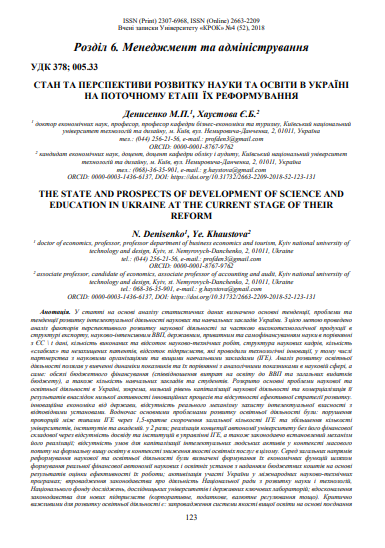THE STATE AND PROSPECTS OF DEVELOPMENT OF SCIENCE AND EDUCATION IN UKRAINE AT THE CURRENT STAGE OF THEIR REFORM
DOI:
https://doi.org/10.31732/2663-2209-2018-52-123-131Keywords:
educational activity, scientific activity, innovation activity, capitalization of scientific activity, capitalization of educational activity, financial autonomy, quality of educationAbstract
In the article, based on the analysis of statistical data, the main trends, problems and trends in the development of intellectual activity of scientific and educational institutions of Ukraine are assigned. For this purpose, an analysis of the factors of prospective development of scientific activity was carried out in terms of the proportion of high-tech products in the export structure, science-intensive GDP, public, private and self-financing of science compared with EU data, the number of completed and the percentage of scientific and technical works, structure of scientific personnel, the number of “weak” and unprotected patents, the percentage of enterprises that conducted technological innovations, including and partnerships with scientific organizations and institutions of higher education (IHE). Analysis of the development of educational activities consisted in the study of the dynamics of indicators and their comparison with similar indicators in the scientific field, namely the amount of budget financing (the ratio of education expenditures to GDP and total budget expenditures), as well as the number of educational institutions and students. The main problems of scientific and educational activities in Ukraine are disclosed, in particular, the low level of capitalization of scientific activities and the commercialization of its results as a result of low activity of innovation processes and the lack of an effective strategy for the development of an innovative economy from the state, the absence of a real mechanism for protecting intellectual property with relevant institutions. At the same time, the main problems of the development of educational activities were: the violation of proportions between the types of IHE due to a 1.5-fold reduction in the total number of IHE and an increase in the number of universities, institutes and academies by 2 times; the implementation of the concept of university autonomy without its financial component due to the lack of experience and institutions in the management of IHE, as well as the legislatively established mechanism for its implementation; the absence of conditions for the capitalization of intellectual human assets in the context of mass demand for formal higher education in the context of a decline in the quality of educational services in general. Among the general directions of reforming scientific and educational activities were identified the formation of their economic functions through the formation of real financial autonomy of scientific and educational institutions with the provision of budgetary funding based on the results of evaluating the effectiveness of their work; the intensification of Ukraine’s participation in international scientific and technical programs; the implementation of legislation on the activities of the National Council for the Development of Science and Technology, the National Foundation for Research, research universities and state key laboratories; improvement of legislation for start-ups (corporate, tax, currency regulation, etc.). Critical for the development of educational activities are: the introduction of a quality system of higher education based on a combination of higher education standards and a unified state qualification exam for admission to undergraduate and graduate programs; reforming the system of state financing of higher education and public procurement for the training of specialists with higher education; settling the status of colleges as a leading link in vocational education; implementation of legislation on the activities of the National Agency for Quality Assurance of Higher Education.
Downloads


